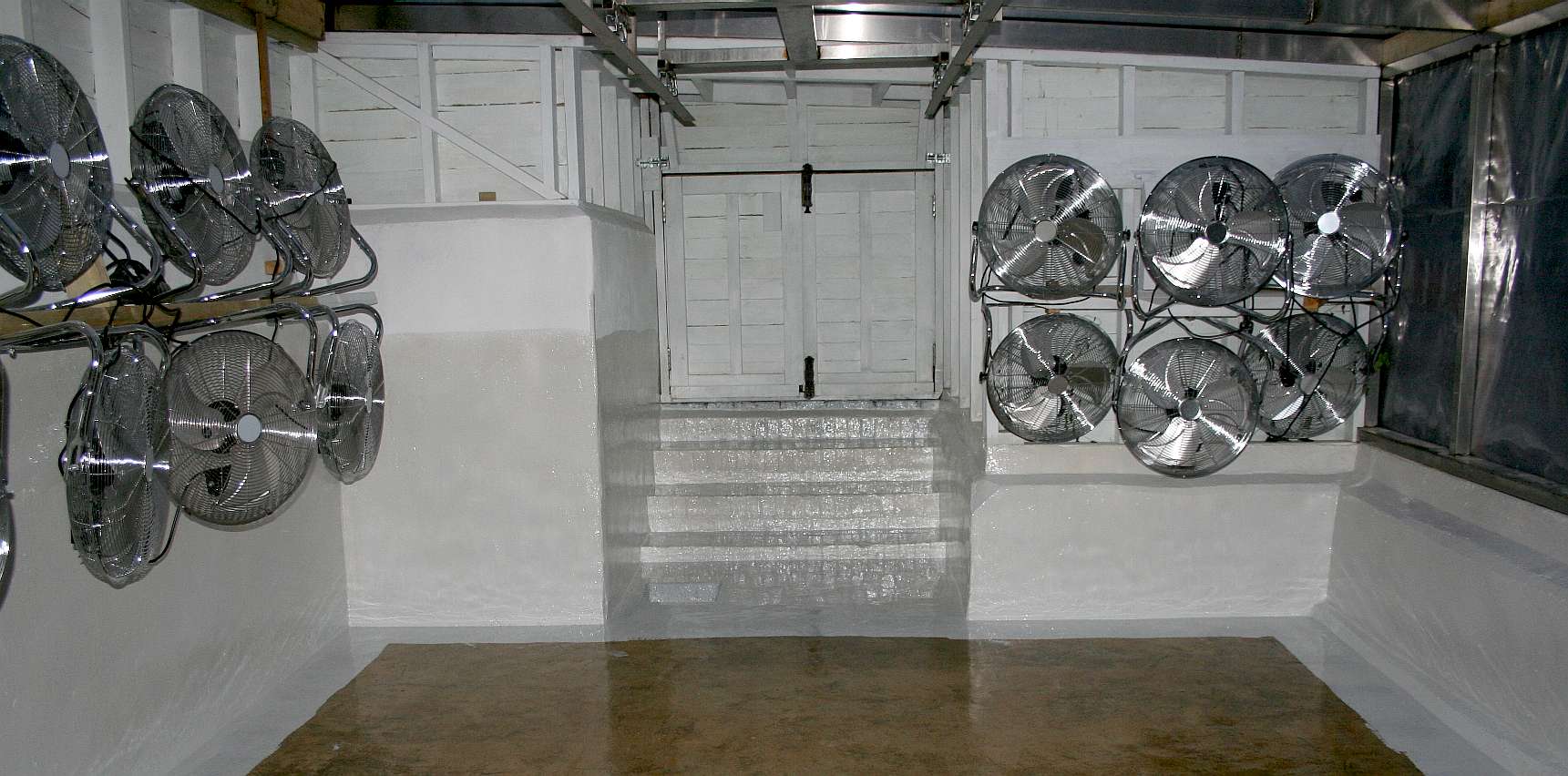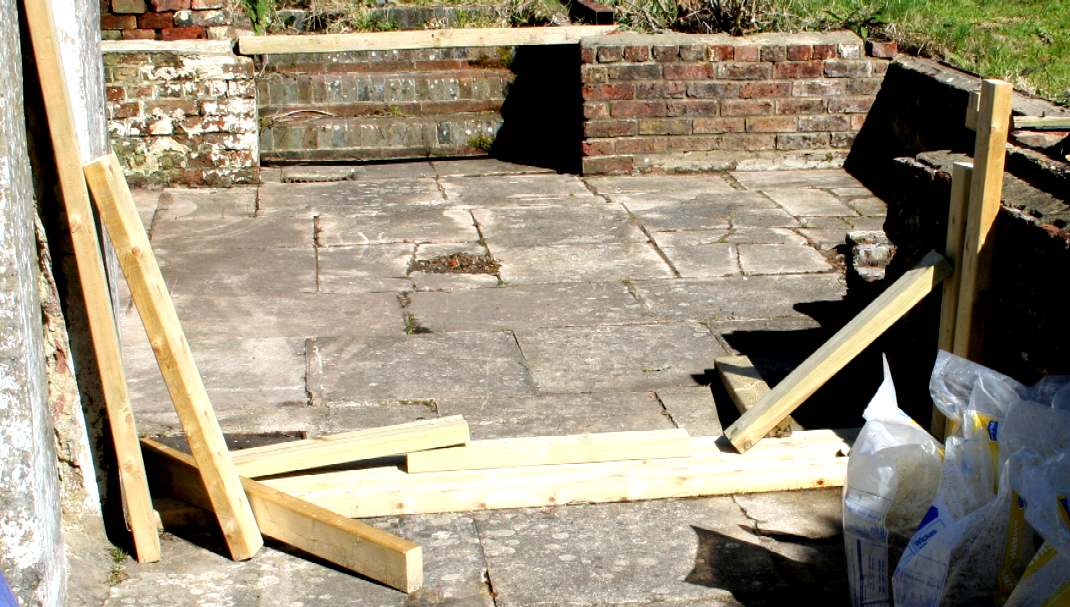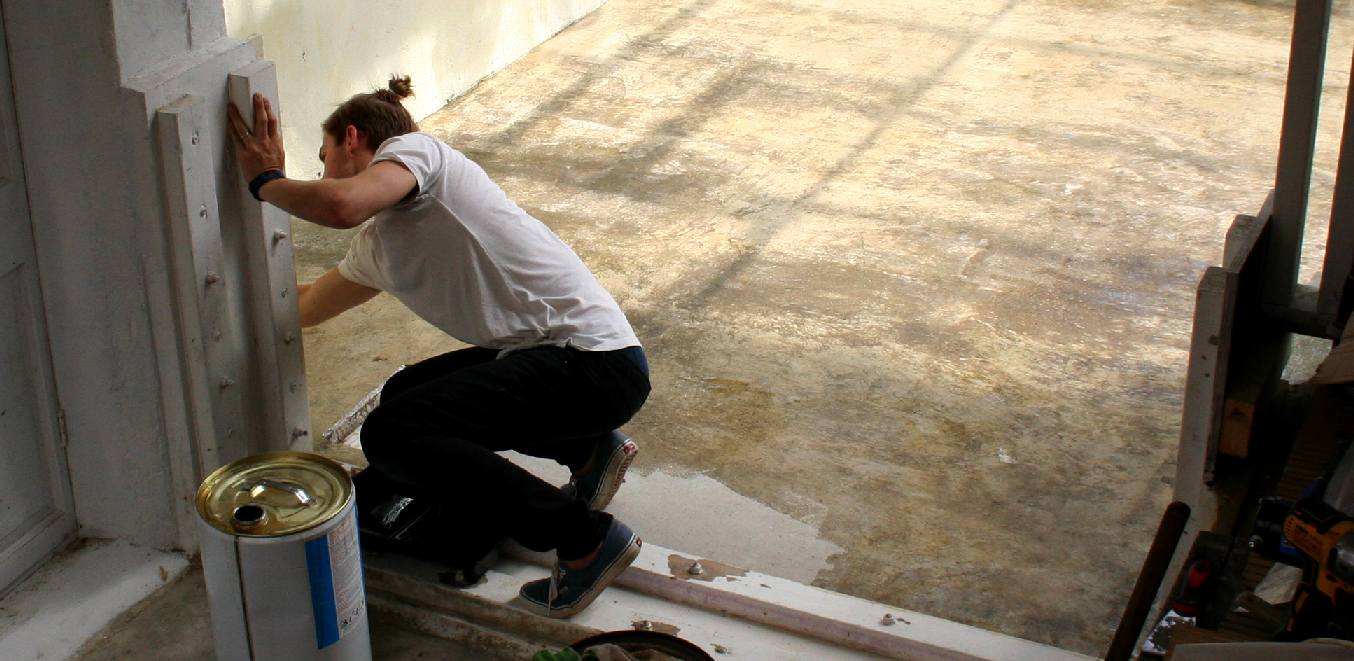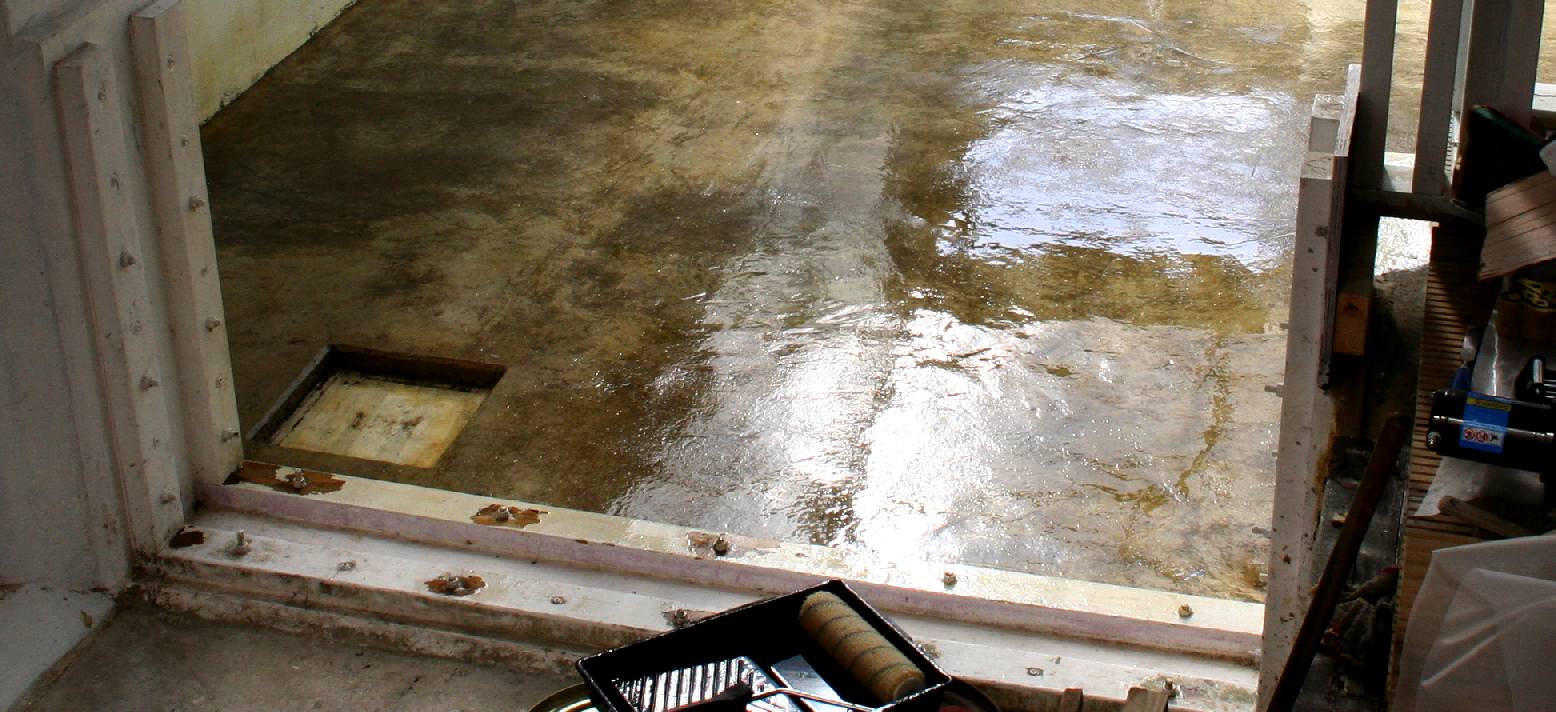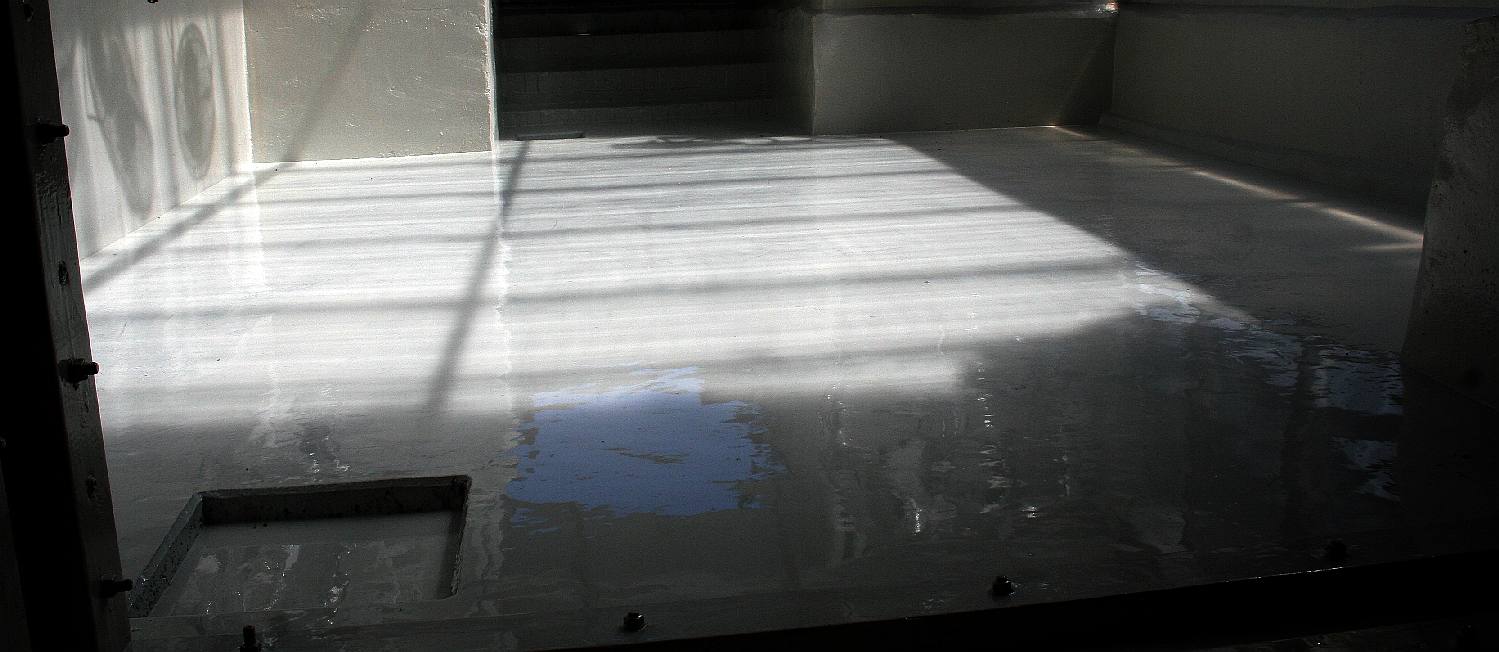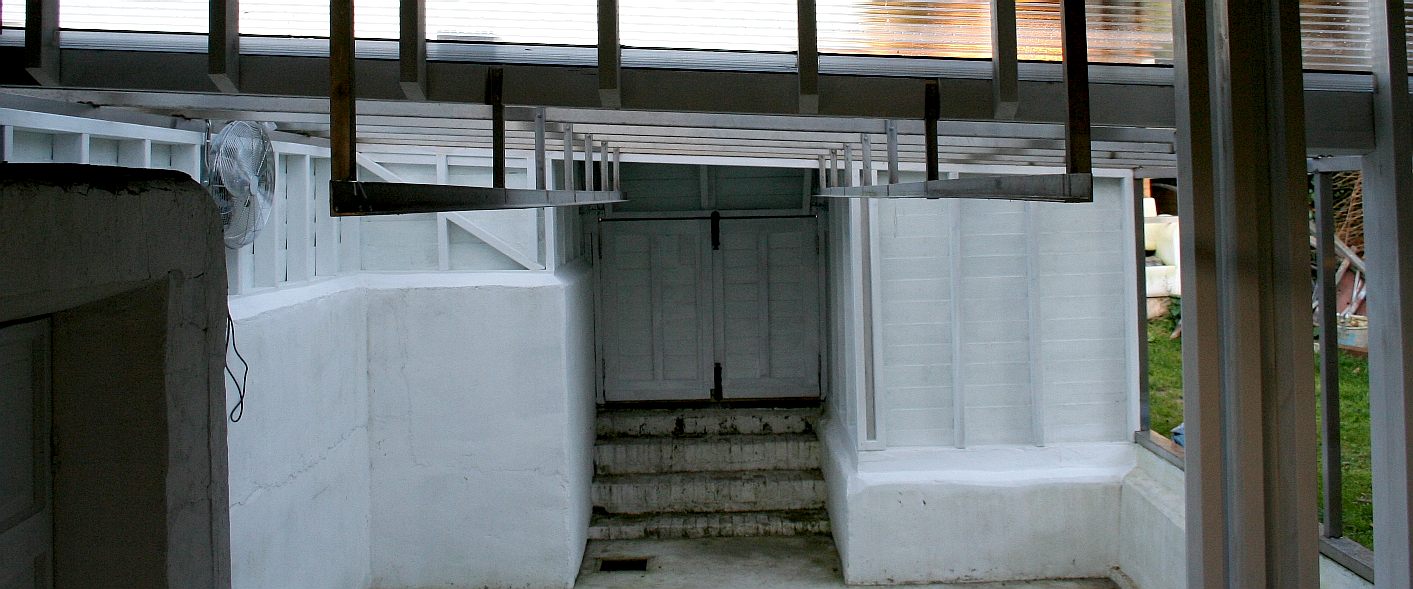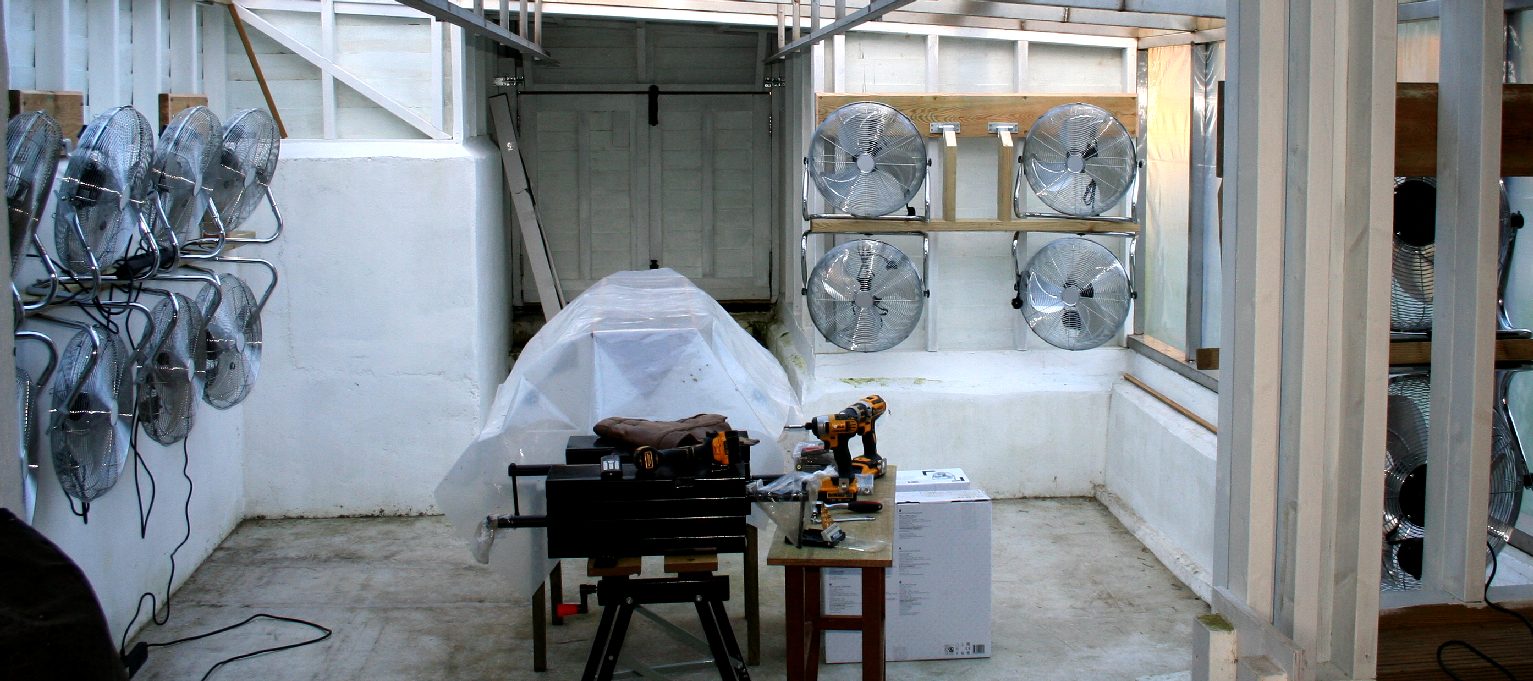|
TANK SEALING & PAINTING
ABOUT - CONTACTS - DONATE - FOUNDATION - HOME - A-Z INDEX
BRICKWORK - CARRIAGE - DRAINAGE - FACILITIES - FILTRATION - GLASS & PAINT - GANTRY - GIMBALS - HATCHES HYDRODYNAMICS HISTORY - INSTRUMENTS - LABORATORY - LAMINATING - LOGISTICS - OUR TEST TANK - PROOFING - REVIEWS - SCREED SEALING - SEAVAX TEST VIDEOS - SLUICE GATE - SLUICE MOTOR - SOLAR BATTERIES - WAVE MAKING - WINCH - WIND MACHINE - MOUNTINGS
WHITE EPOXY - First coat of epoxy paint, including repairing and sealing a small leak in the corner of the sluice gate. Copyright © photograph 8 July 2018. We ran out of paint, having used 10 liters to get this far. Not a problem thanks to Ebay and the repeat orders function. In a few days time we'll have another batch and we'll be able to complete the task. All rights reserved. You will need the permission of the Cleaner Ocean Foundation to reproduce these photographs except for educational use or private research.
APRIL 2016 - Hard to believe, but this is the same area before it was cleared of rubbish and weeds to make way for a water basin. In the foreground are cut timbers that will make up the sluice gate. The walls were repaired and rendered, floor screeded and a canopy added from which a gantry hangs for the carriage that SeaVax and other designs will be suspended from in future tests. From June 2016 until June 2017 this work was funded by Avaaz. Since then we have taken over development and unable to move so fast because of funding difficulties during a transition period if we over-extend ourselves, and also with Brexit making it unattractive to even consider applying for EU funding under the Horizon 2020 and EMFF calls. We are not eligible for UK calls from Theresa May's £61 million warchest, being a not-for-profit and being unable to match fund where we are not a business. It is though great news that other conservation groups and marine academics might benefit - and who knows they may come up with an alternative solution before we are funded and save us the bother. Any organization who is financially and technically capable of developing a SeaVax replacement is more than welcome to take up the torch. Copyright © April 2016, all rights reserved. You will need permission from Bluebird Marine Systems Ltd to reproduce this photograph.
KARCHER - The test tank was painted white, but the paint system was not durable and the tank leaked from the joins in the flagstones. We used a Karcher jet washer to remove loose paint, before priming for a cement screed. The T5 premium washer operates at 145 bar, another good deal from Screwfix. This machine is feature packed and we love it where it saved us so much time. Copyright © May 26 2017, all rights reserved. You will need permission from Bluebird Marine Systems Ltd to reproduce this photograph except for private research and educational use.
CURING THE LEAKS - After several test sessions that did not quite go according to plan, the Cleaner Ocean Foundation bit the bullet and screeded the test tank floor with a sharp sand and cement mix. Copyright © May 26 2017, all rights reserved. You will need permission from Bluebird Marine Systems Ltd to reproduce this photograph except for private research and educational use.
G4 POLYURETHANE - First coat of the well known waterproofing and priming resin that penetrates deep into the concrete screed to seal the porous surface. In this picture you can see how dry the floor was and that the sealant is soaking in nicely. Copyright © photograph 28 June 2018. All rights reserved. You will need the permission of the Cleaner Ocean Foundation to reproduce these photographs except for educational use or private research.
Having suffered leaks that put us back a whole season in terms of our testing programme we bit the bullet and screeded the floor with a sharp sand based concrete.
We left the concrete to cure in 2017 taking us into the next season with all the development work that was going on. In June of 2018 we had a slot to paint the tank white again. White may not be the final colour for all our tests, but it will allow us to film the SeaVax and AmphiMax vehicles in action.
The first stage was to jet-wash the concrete to remove algae from roof leaks the previous year. We then applied a fungicidal wash and rinsed that off. It took another three days for the concrete screed to dry before the G4 sealant could be applied. But before that we had to remove two temporary wooden frames that were made inside the drains at each end of the tank. Although we don't use these drains, they may be useful in an emergency, or where we need to pump out the basin from a sump inside one of the drains.
It is important that you follow the instructions and make sure that the concrete is dry before applying the first coat. The 1st coat of G4 was sucked in by the thirsty screed. You must apply a second and, if necessary, a third coat within four hours of the previous coat, or the adhesion will not be sound. We waited 3 hours in the hot summer sun, then the tank was more that dry enough for the next application, but still tacky enough to ensure a good bond.
It is not worth trying to wash out rollers, it taking more thinners than the cost of a replacement sleeve. Simply throw away the used sleeve and peel off the dried G4 from the roller tray, where G4 does not adhere well to polypropylene or polythene plastics.
SEALED - The second coat went on much easier and was applied thickly, but not so thick that we had runs, although you will get some flow, especially on a floor like ours where there is a slope to the circulating pump intake in one corner. Copyright © photographs June 28 2018. All rights reserved. You will need the permission of the Cleaner Ocean Foundation to reproduce these pictures except for educational use or private research.
TWO PACK EPOXY
The next stage is to apply a good coat of 2-pack epoxy floor paint to the cured G4 resin. We had a bad experience with an epoxy supplier, where the paint component had hardened in the can before we could apply it. It must have been old stock. This was purchased online. Be careful then to only buy your paint just before you intend using it. If you leave it for a season, you may have the same trouble, and it is very annoying - and of course - expensive.
WHITE EPOXY - Second coat of the plastic floor paint, and it sure is glossy. Copyright © photograph 15 July 2018. You will need the permission of the Cleaner Ocean Foundation to reproduce these photographs except for educational use or private research.
PLASTICS & PAINTS
G4 resin and Epoxy paints are examples of plastics that are not single use. They are resins that are reasonably necessary and enhance life, without getting into our eco-system, provided that when being maintained the dust and flakes are disposed of carefully. Humans could not do without paints and preservatives in a modern society.
OVERHEAD GANTRY - The water test-tank looked like this in October of 2017, bereft of our beloved wind machines. The tank area was waiting for a couple of coats of epoxy paint before it can be used for experiments later in 2018. Note the algal build up on the brick steps. We were careful to make sure that these and the cement were sealed thoroughly. Copyright © photograph. All rights reserved. You will need the permission of the Cleaner Ocean Foundation to reproduce this picture except for educational use or private research.
FAN BANKS - In this picture you can see the bank of ten fans on the left of our test tank, four on the far wall and two on the near wall. The whole assembly can be lifted up and out of the way when wind is not needed for any of the tests. Wind testing is though very important where the SeaVax and the Elizabeth Swan (seen here under cover) are both powered by wind turbines and large solar arrays, or wings, that move to track the sun. In windy conditions the solar wings will act like sails and could overturn the vessel they are attached to if we do not run a series of scale tests to determine what are the safe working parameters for our robotic engineers to program into the operating system.
The 'Elizabeth Swan' is a high-speed wave-piercing boat that could be used to set a new world record for solar boats one day, but is also the vessel in a series of eco adventure stories that are yet to be published by Jameson Hunter. This boat was named after the character played by Keira Knightley in Disney's "Pirates of the Caribbean." Copyright © drawings February 23 2018. All rights reserved. You will need the permission of the Cleaner Ocean Foundation to reproduce these pictures except for educational use in classrooms, for homework projects, university lectures, or for private research.
LINKS & REFERENCE
http....
BRICKWORK - CARRIAGE - DRAINAGE - FACILITIES - FILTRATION - GLASS & PAINT - GANTRY - GIMBALS - HATCHES HYDRODYNAMICS HISTORY - INSTRUMENTS - LABORATORY - LAMINATING - LOGISTICS - OUR TEST TANK - PROOFING - REVIEWS - SCREED SEALING - SEAVAX TEST VIDEOS - SLUICE GATE - SLUICE MOTOR - SOLAR BATTERIES - WAVE MAKING - WINCH - WIND MACHINE - MOUNTINGS
This website is provided on a free basis as a public information service. Copyright © Cleaner Oceans Foundation Ltd (COFL) (Company No: 4674774) 2018. Solar Studios, BN271RF, United Kingdom. COFL is a charity without share capital. The names Amphimax™ RiverVax™ and SeaVax™ are trademarks.
|
